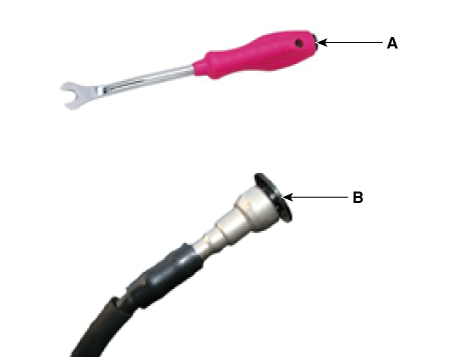Kia Sportage: Fuel Delivery System / High Pressure Fuel Pump Repair procedures
Kia Sportage QL (2015-2025) Service Manual / Engine Control / Fuel System / Fuel Delivery System / High Pressure Fuel Pump Repair procedures
| Removal |
In case of removing the high pressure fuel pump, high pressure fuel
pipe, delivery pipe, and injector, there may be injury caused by leakage
of the high pressure fuel. So don’t do any repair work right after engine
stops.
|
| 1. |
Release the residual pressure in fuel line.
(Refer to the Fuel Delivery System - "Release Residual Pressure in Fuel
Line")
|
| 2. |
Turn the ignition switch OFF and disconnect the battery negative (-)
terminal.
|
| 3. |
Disconnect the fuel pressure control valve connector (A) and the fuel
feed tube quick-connector (B).
|
| 4. |
Remove the high pressure fuel pipe.
(Refer to Fuel Delivery System - "Fuel Line")
|
| 5. |
Remove the installation bolts (A), and then remove the high pressure
fuel pump (B) from the cylinder head assembly.
|
| Installation |
|
|
|
| 1. |
Install in the reverse order of removal.
|
 Delivery Pipe Repair procedures
Delivery Pipe Repair procedures
Removal
In case of removing the high pressure fuel pump, high pressure fuel
pipe, delivery pipe, and inject ...
Other information:
Kia Sportage QL (2015-2025) Service Manual: SS-A Solenoid Valve (ON/OFF) Repair procedures
Inspection 1. Switch "OFF" ignition. 2. Remove the battery and battery tray. (Refer to Engine Electrical System - "Battery") 3. Disconnect the solenoid valve connector (A). ...
Kia Sportage QL (2015-2025) Owners Manual: Emission control system
The emission control system of your vehicle is covered by a written limited warranty. Please see the warranty information contained in the Warranty & Consumer Information manual in your vehicle. Your vehicle is equipped with an emission control system to meet all applicable emission regul ...
Copyright © www.ksportagegl.com 2015-2025











